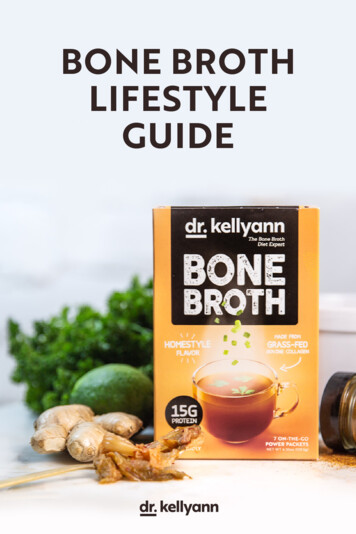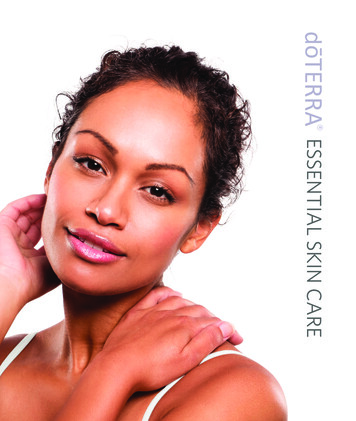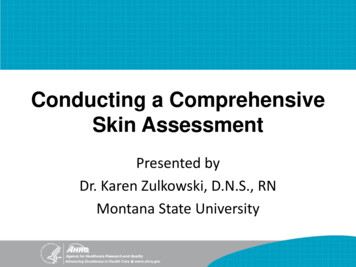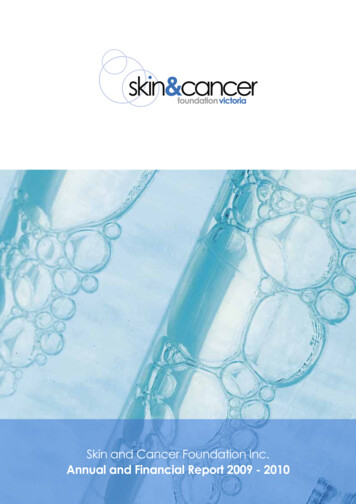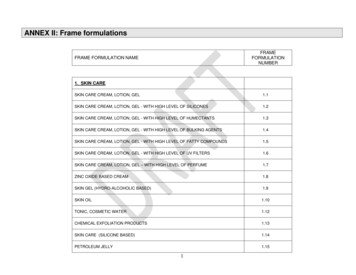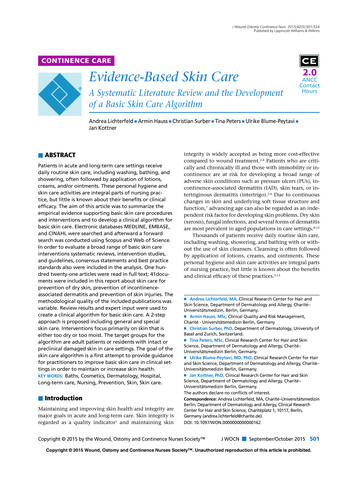
Transcription
Reilly et al. Plast Aesthet Res 2021;8:2DOI: 10.20517/2347-9264.2020.153Plastic andAesthetic ResearchOpen AccessReviewSkin collagen through the lifestages: importance forskin health and beautyDavid M. Reilly1, Jennifer Lozano21Research and Clinicals, Minerva Research Labs, London W1S 1DN, UK.NPD and Regulatory, Minerva Research Labs, London W1S 1DN, UK.2Correspondence to: Dr. David M. Reilly, Research and Clinicals, Minerva Research Labs, 106 New Bond Street, Mayfair, LondonW1S 1DN, UK. E-mail: davidr@minervalabs.comHow to cite this article: Reilly DM, Lozano J. Skin collagen through the lifestages: importance for skin health and beauty. PlastAesthet Res 2021;8:2. ved: 20 Jul 2020 First Decision: 2 Oct 2020 Revised: 15 Oct 2020 Accepted: 9 Dec 2020 Published: 8 Jan 2021Academic Editor: Salvador Gonzalez, Raúl González-García Copy Editor: Monica Wang Production Editor: Jing YuAbstractCollagen-based supplements have become a keystone in the management of the ageing process, with proven abilityto repair skin damage, bestowing a youthful and healthy appearance sought in the pursuit of beauty. Collagen is anessential scaffold protein that gives smoothness and elasticity to skin, but its production declines with age. Findingways to tackle this problem is now strongly promoted as an effective way to transform skin and hair, repairing agerelated deterioration. A growing number of scientific studies show exciting evidence that it is possible to rejuvenateageing or damaged skin, improve function of worn joints, and support personal wellbeing and vitality. In recenttimes, research on the mechanisms which impact the production of collagen in skin and the ideal organization intofunctional fibres which give skin its characteristic elasticity and firmness has provided new insights into how thisbio-scaffold can support cells, tissues and organs. The factors which influence collagen production over a lifetime(e.g., puberty, pregnancy, menopause, andropause), intrinsic factors (e.g., genetics, age, ethnicity) and extrinsicfactors (e.g., UV-radiation, pollution, smoking) and the potential for new technologies, ingredients and devices torestore collagen and matrix components to their optimal condition are improving the ability to deliver anti-agingstrategies with unprecedented results. This paper will review skin collagen production, structure and functionthroughout the lifestages, emphasizing its relationship with health, appearance and beauty.Keywords: Collagen, health, beauty, ageing, skin The Author(s) 2021. Open Access This article is licensed under a Creative Commons Attribution 4.0International License (https://creativecommons.org/licenses/by/4.0/), which permits unrestricted use,sharing, adaptation, distribution and reproduction in any medium or format, for any purpose, even commercially, as longas you give appropriate credit to the original author(s) and the source, provide a link to the Creative Commons license,and indicate if changes were made.www.parjournal.net
Page 2 of 24Reilly et al. Plast Aesthet Res 2021;8:2 I DUCTIONSynthesis and structure of collagen in skinCollagen Synthesis by fibroblastsCollagen provides the support matrix/mattress underpinning healthy skin and is a key determinant to thepreservation of skin firmness and elasticity[1,2]. Type I is the main collagen found in skin, representing 80%90% of skin collagen. It is produced by cells called fibroblasts, which are a mesenchymal cell type, foundpredominantly in the dermis[3]. Fibroblasts also produce elastin protein which gives skin the flexibility tostretch by facilitating a long-range deformability, followed by a recoil to allow tissues to return to theiroriginal conformation[4,5]. This is a critical functionality to maintain the skin elasticity and resilience[Figure 1]. Another product of fibroblast metabolic function is the production of glycosaminoglycans(GAGs) which are long unbranched heteropolysaccharides such as hyaluronates and dermatan sulphate(the most abundant GAG in skin). The unique combination of high viscosity, high hygroscopicity and lowcompressibility are key to their many functions, including maintenance of the skin’s essential moisturecontent[6].Fibroblasts are sensitive to the physical tension of the extracellular matrix (ECM) in which they areembedded, and to biochemical stimuli and signalling pathways, both of which can induce fibroblastactivation and proliferation[7]. Small molecular weight, diffusible ligands can bind to receptors located onthe fibroblast extracellular membrane inducing their activation. Physical tension in the ECM can directlycause activation of mechanoreceptors and anchoring fibrils of the inherent cytoskeletal framework andinitiate signalling pathways involved in cell-to-ECM communication[8]. The activation of fibroblasts resultsin an increase in the production of collagen, elastin and associated GAGs[9].Many anti-ageing strategies are targeted at influencing production of ECM components by fibroblasts. Awide range of ligands can influence fibroblast proliferation and activation, including bioactive peptides,antioxidants, retinoids, vitamins, ω6- and ω3-fatty acids, growth factors, hydroxy acids and a bewilderingarray of botanical extracts[10-12]. A common theme for the majority of these ingredients is that they caninfluence, either directly or indirectly, the production of collagen and ECM components.From early adulthood, fibroblasts become less active and collagen production declines by about 1.0%1.5% a year[13,14]. This can also be aggravated by certain lifestyle choices like smoking and external factorslike sun exposure[15]. Ongoing sunlight and pollution exposure and reduced efficiency in eliminatingfree radical chemicals add to the damage. Many studies have shown that if collagen peptides (and otheractive compounds) are ingested they will travel throughout the body, including to sites where fibroblastsare present. This stimulates fibroblasts to produce more collagen, elastin and hyaluronic acid, therebyrejuvenating skin and other tissues. This mechanism is key to the successful production of collagenreported in clinical studies following long term supplement use and the consequent reported improvementin skin elasticity and hydration.A recent in vitro study from Edgar et al.[16] has shown that hydrolysed collagen peptides significantlyincrease collagen and elastin synthesis by fibroblasts while significantly inhibiting the release of twocollagenases, namely metalloproteinase-1 (MMP-1) and MMP-3. The research primarily investigated theinteractions between collagen peptides and other constituents (including GAGs and antioxidants) presentin the hydrolysed collagen-based nutraceutical, Gold Collagen Forte, on normal primary dermal fibroblastfunction. The effects of the addition of collagen peptides, alone or in combination with other bioactive andantioxidant constituents, were tested and compared to the effect of media alone. The increase in collagenand elastin synthesis was accompanied by a decrease in the activity of MMP enzymes. MMP enzymes areresponsible for matrix breakdown and elastin degradation and an increase in MMP activity is associatedwith UV-irradiation and reactive oxygen based free radical damage to the ECM components[17,18]. The
Reilly et al. Plast Aesthet Res 2021;8:2 I http://dx.doi.org/10.20517/2347-9264.2020.153Page 3 of 24Figure 1. The production of collagen fibres in the dermis. The fibroblast secretes the procollagen fibre into the extracellular matrix,where they form larger collagen bundles. Elastin is also secreted and assembled into the collagen-based macromolecular structure. (Bypermission of MINERVA Research Labs Ltd - London)data provided a scientific, cell-based, rationale for the positive effects of collagen-based nutraceuticalsupplements on skin properties, suggesting that enhanced formation of stable dermal fibroblast-derivedECM may follow their oral consumption.Collagen fibril formation and characterizationThere are about 28 different forms of collagen expressed in the body, of which the molecular biology, biochemistryand ECM structural and architectural components have been reviewed in detail by Shoulders et al.[2,19]and in concise overview by Kadler et al.[20]. The family of proteins includes both fibril-forming and nonfibril-forming proteins, however the main collagens involved in skin architecture and physiology arethe fibril-forming types, predominantly Type I and Type III (the Roman Numerals denote the order ofdiscovery). Each protein is encoded by a series of genes, with gene loci for the members of the collagenfamily labelled with the abbreviation “COL”, followed by annotation for both collagen type and constituentchains, e.g., COL1A1 for the α1 chain of Type I collagen[21]. Type I collagen, the prototype and also themost abundant member, has a long chain triple helix structure, comprising a heterotrimer of two identicalαl(l) chains and one α2(I) chain [Figure 2]. A major structural determinant of the protein is a triplehelical structure of three polypeptide chains with a characteristic amino acid sequence (Gly-X-Y) which isrepeated frequently across the fibril structure, where Gly is glycine and X and Y would frequently be aminoacids such as proline and hydroxyproline[22].Genes coding for the alpha chains of collagens are transcribed into RNA and translated into protein inthe endoplasmic reticulum of the fibroblast cell and processed within a secretory vesicle. Binding of the3 individual chains at the C-terminus initiates formation of the triple helix, which proceeds towards theN-terminus in a zipper-like manner [Figure 2]. This allows assembly of α-chains through a trimerizationprocess to form pro-collagens, which are further assembled into fibrils[23]. Following secretion of thecollagen triple helix structure into the ECM, post-translational cleavage of the N- and C-terminal peptidesoccurs [Figure 3].
Page 4 of 24Reilly et al. Plast Aesthet Res 2021;8:2 I e 2. Collagen fibril formation. Collagen genes are transcribed into RNA and translated into protein in the fibroblast cell. Posttranslational processing occurs, followed by binding of the 3 individual chains at the C-terminus. The 3 chains are tightly bound togetherand supported with cross-links which stabilise the structure. This trimerization process allows assembly of α-chains which are furtherassembled into fibrils. (By permission of MINERVA Research Labs Ltd - London)The uniquely high content of the amino acids proline (or more specifically imino acid, wherein thesecondary amine results in a rotationally constrained rigid-ring structure which imparts unique structuralstability) and lysine allows a range of post-translational modifications due to the hydroxylation ofproline and lysine residues[24]. Lysine hydroxylation allows for crosslinking of intertwined fibres andgives the insoluble protein unique characteristics including thermal stability, mechanical strength anda 3-dimensional structure amenable to production of coiled fibres which are very resilient to the variedmechanical and biological forces experienced during a lifetime [Figure 3][25].Type I collagen is present in skin, tendon, vasculature, organs and bone (it is the main component of theorganic part of the bone, a scaffold which is subsequently mineralized to produce a structure stronger thansteel and yet light enough to facilitate mobility and speed). Type II is predominantly present in cartilage, asubstance many times smoother than glass, with a very low friction coefficient, yet it is not brittle and doesnot crack under pressure. Type III is commonly found alongside Type I and usually represents about 15%of skin collagen. It is a homotrimer composed of three identical α1 peptide chains.Collagen fibres form extensive and robust networks providing the dermis with strength, firmness andelasticity. As shown in Figure 4, a collagen fibre is typically up to 3 μm in diameter and has a characteristiccoiled structure[2,26]. A collagen fibre is essentially comprised of bundles of smaller fibrils. Collagen fibrilsare approximately 10 to 300 nm in diameter and several micrometres in length. A collagen fibril is a bundleof triple stranded collagen molecules (about 1.5 nm in diameter and approximately 300 nm long). This
Reilly et al. Plast Aesthet Res 2021;8:2 I http://dx.doi.org/10.20517/2347-9264.2020.153Page 5 of 24Figure 3. Collagen synthesis, secretion into the ECM and cross-linking. Collagens are translated into protein on the ribosomes of theendoplasmic reticulum inside the fibroblast cell. Hydroxylation and glycosylation occur before the 3 helical strands are woven togetherto form the procollagen species. After secretion into the ECM, the N-terminal and C-terminal ends are cleaved and the tropocollagenunits can be assembled into larger structure, which are held together via crosslinked residues between the Lysine aldehyde derivativeof one collagen strand and the corresponding hydroxylysine of the opposite strand. (By permission of MINERVA Research Labs Ltd London)triple helix, coiled structure is stereo-dynamically favourable to allow strands to be interwoven togetherand this incredibly robust structure can persist in tissues for many years[27,28].Formation of fibres is dependent on interaction with other ECM components including elastin proteinsand GAGs. All GAGs except hyaluronan (HA) bind to collagen via electrostatic interaction under normalphysiological conditions[29]. The hypothesis is that proteoglycan-collagen interaction directly influencesthe deposition of collagen fibres in situ, although further research is required to clarify the mechanismsinvolved. Protein and GAG interactions thus determine the synthesis, secretion and formation of collagenbased matrix, whereas the osmotic equilibrium in connective tissue is determined by the rapid turnover ofGAGs such as HA and dermatan sulphate[9,30].Non-invasive imaging systems can be used to visualise and quantify collagen in the skin. Ultrasounddevices are available for use in clinical studies depending on the required application and study design,e.g., measuring collagen in skin versus tendon, body site tested (arm versus face), resolution (µm),sensitivity and depth of skin measurement (papillary versus reticular dermis). The range of frequenciesfor skin imaging is recommended to be 20-25 Mhz. Imaging by confocal microscopy has gained immense
Page 6 of 24Reilly et al. Plast Aesthet Res 2021;8:2 I e 4. The organization of collagen fibrils into fibre bundles. Individual α-chains are woven into triple helices via a zipper mechanism.Bundles of triple helices form fibrils and these fibrils are aggregated into larger fibres. (By permission of MINERVA Research Labs Ltd London)importance as technological advances in resolution have enabled dermal components to be visualized andquantified in exquisitely fine detail. Multiphoton microscopy (MPM) and reflectance confocal microscopy(RCM) have demonstrated promising results in imaging skin micromorphology. The RCM has become avital tool in analysing accurately the cellular images of in vivo human skin to study the variations of cellularparameters such as cell size, nucleus size, keratinocyte morphology (which becomes increasingly irregularwith age or inflammation) and in diagnosing morphometric features of collagen fibre type [31]. In thedermis fibrillary grading of collagen types, classified as hypo-reflective versus hyper-reflective structuresindicating fibre intensity and definition, whereby a hypo-reflective collagen makes it difficult to identifysingle fibres, compared to a hyper-reflective collagen fibre which is well defined and fibrous in nature[32].Further characterisation of the type of collagen as thin reticulated, coarse, huddled, or curdled, allows moredetailed description of skin collagen and changes observed throughout the lifestages.In an elegant series of studies, Ueda et al.[33] used combined MPM imaging and biaxial tissue extension toshow the in vivo, 3-dimensional architecture of collagen fibre organization in the reticular dermis of menand women, with ages ranging from 36 to 75 years. The tissue was collected during reconstructive surgery.The technique allowed detailed imaging of fibres in situations ranging from tight packing of intertwinedfibres to extended or expanded conformation. They showed that in the reticular dermis there are relativelylarge collagen fibres with a distinctive wavy morphology, densely packed but still distinctly visible asintertwining structures with horizontal laminar organization They further showed that the structure of thedermis varies by depth, e.g., collagen fibres are thicker in the deep reticular dermis and are more denselypacked in the middle dermal zone. These insights are advancing our understanding of the fundamentalmechanisms underlying the role of collagen in determining the pliability of human skin.COLLAGEN PRODUCTION THROUGH THE LIFESTAGESCollagen production first begins in utero at about the 5th week of the first trimester of pregnancy, at whichtime fine collagen fibrils can be observed in the developing foetus[34]. During subsequent developmentcollagen matrix increases and is associated with larger fibrils being assembled into larger bundles. Asearly as 15 weeks into gestation distinct regions of papillary and reticular dermis can be distinguished.
Reilly et al. Plast Aesthet Res 2021;8:2 I http://dx.doi.org/10.20517/2347-9264.2020.153Page 7 of 24Type I collagen content is approximately 70%-75%, compared to type III collagen which is approximately18%-21%, of the total of collagen content at all gestational ages. This level of Type I collagen is lower thanmeasured in adult skin ( 85%-90%), whereas the Type III is higher than that observed in adult skin ( 8%-11%). It is believed that this difference reflects the higher requirements of collagen production tosupport the developing vasculature and innervation of the foetus. The activities of the enzymes required tosynthesise collagen fibres have been reported to vary with age, e.g., the enzyme activities of hydroxylasesand glucosyltransferase were expressed maximally in foetal skin, retaining a higher level of activity in theskin of young children compared to adults[35].During childhood, through prepubertal growth stages and pubertal changes caused by the production ofsex hormones in adolescents, there is rapid and extensive collagen turnover. The majority of publicationson collagen production in prepubertal and pubertal adolescents is concerned with Type I collagen usedas the organic support matrix which is mineralized for the development of bone. Collagen is constantlybeing synthesised, laid down in the ECM, only to be degraded by enzymes, in particular the MMPs, ina balanced cycle which allows growth. This turnover of collagen is rapid during development and thenquiescent during adult years but increases again in later life to compensate for cumulative deleteriousdamage associated with chrono-ageing and photo-ageing[36,37]. Thus, collagen synthesis and degradation areprecisely controlled and biochemically complex processes, which is pivotal to tissue development, tissuerepair following damage and tissue maintenance in varied anatomical and physiological systems.Skin ageing results from a series of divergent processes which affect many constituents of the skin andhence its appearance. There are two primary skin ageing mechanisms, referred to as intrinsic and extrinsic.These intrinsic processes are controlled predominantly by genetic and hormonal variations, whereasextrinsic components include smoking, alcohol consumption, chronic sun exposure, stress, and severalother factors. Extrinsically aged skin is characterised by several clinical manifestations including thepresence of fine lines and increased wrinkle formation, reduced recoil capacity, increased fragility of theskin and altered melanogenesis and skin pigmentation.The proportion of the collagen types in skin change with age[38]. Young skin is composed of 80% type Icollagen and about 15% collagen type III[39]. With age, the ability to replenish collagen naturally decreasesby about 1.0%-1.5% per year. This decrease in collagen is one of the characteristic hallmarks associated withthe appearance of fine lines and deeper wrinkles [Figure 5]. Moreover, deep inside in the dermis, fibrillarcollagens, elastin fibres and hyaluronic acid, which are the major components of the extracellular matrix,undergo distinct structural and functional changes.Collagen and elastin are stable proteins with a half-life measured in years (t 1/2 for skin collagen isapproximately 15 years) and hence are predisposed to long term cellular stress [40]. In considering thecollagen bundle it is obvious that the bulk of the collagen protein is inaccessible due to the close packingof individual fibrils. Even in the outer sheath the proteins are chemically cross-linked to the fibres insidethe bundle and are thus not readily cleaved by proteases. This highlights the importance of MMP enzymeswhich can cleave the collagen triple helix and make the fibre accessible to degradation enzymes and cellularrecycling[41].In the family of MMPs, it is the collagenases that are required to carry out the first degradation step, inwhich the fibres are cleaved into characteristic ¼ and ¾ fragments [Figure 6]. According to the LauerFields model, cleavage occurs at the border of a tight triple helix region (high in imino acid content) and aloose triple helix region (low in imino acid content), where the enzyme can unwind the triple helix strandsand initiate hydrolysis of the individual strands[42]. Following this first step, other proteinases continue thedegradation of the collagen fibres, including gelatinase (MMP-2), serine proteinases, cysteine proteinases,and aspartic proteinases.
Page 8 of 24Reilly et al. Plast Aesthet Res 2021;8:2 I e 5. Collagen content of skin is maximal between the 2nd and 3rd decade, after which there is a slow depletion and loss of collagen(and associated ECM components such as elastin and GAGs). The loss of collagen is clearly correlated with changes to appearanceattributes which are typically referred to as fines lines and wrinkles. (By permission of MINERVA Research Labs Ltd - London)Figure 6. Collagenase (also referred to as Matrix metalloproteinase, MMP) binds and locally unwinds the triple-helical structureallowing subsequent hydrolysis of the exposed peptide bonds. The enzyme preferentially interacts with the α2(I) chain of type I collagenand cleaves the 3 α chains in succession. This results in the derivation of the characteristic 3/4 and 1/4 fragments. (By permission ofMINERVA Research Labs Ltd - London)
Reilly et al. Plast Aesthet Res 2021;8:2 I http://dx.doi.org/10.20517/2347-9264.2020.153Page 9 of 24Figure 7. Collagen content in skin tends to increase until approximately the mid-20s. Thereafter, there is a progressive loss of collagenthrough the decades. (By permission of MINERVA Research Labs Ltd - London)Collagen fibres accumulate damage over time and this decreases their ability to function correctly.Intrinsically aged skin is generally characterised by dermal atrophy with reduced density of collagenfibres, elastin, and hyaluronic acid[43]. In addition to reduced density, the collagen and elastin fibres can beobserved to be disorganized and abnormal in aged skin compared to young and healthy skin[44]. As collagenlevels start to decline, the collagen structure becomes more fragile and brittle leading to a weakening of theskin’s structural support. The skin loses volume and firmness and starts to thin and wrinkle. The reductionin collagen production also coincides with a loss of hyaluronic acid further impacting on the hydration andsuppleness of the skin.In a study published by Sibilla et al.[45], the researchers reported a peak in collagen content for subjectsbetween 25-34 years old, followed by a gradual decline equating to an approximate 25% decrease over 4decades (Percent collagen score 73.28 14.3 at age 25-34 vs. 55.3 13.1 at age 65-74, n 64, Figure 7). Thisdecline in collagen in aged skin has been measured using various methodological approaches, which aregenerally in good agreement and support the hypothesis of collagen loss being a key determinant of agerelated deterioration of skin appearance[46,47].The endocrine system and hormonal effects on skin collagenChanges in hormones levels associated with chrono-ageing affects different parts of the body in variousways. With hormonal changes during teenage years and puberty many adolescents experience acne, causedby an interaction of hormones, sebum-based oils, and resident bacteria and associated with inflammation,redness, and spots. Acne can be severe in clinical presentation and can cause scarring of the skin. Scarringof skin requires tissue remodelling, including remodelling of the collagen-based ECM, to repair the damageassociated with long term inflammation and tissue atrophy.An increase in hormonal levels is accompanied by increased activity of sebaceous glands, with an increasespecially in androgens, resulting in an excess of sebum produced in skin. During early adult life, hormonelevels start decreasing, thus acne symptoms starts to lessen. However, facial lesions can affect peoplethroughout their entire adulthood[48,49]. Women may repeatedly suffer acne in adulthood as this may occurwith their menstrual period, especially for those who suffer from PCOS (Polycystic Ovarian Syndrome).This hormonal disorder affects the menstrual cycle and can increase the severity of acne. Most womensuffer from acne disorders until menopause period when levels of oestrogen start decreasing rapidly[50].
Page 10 of 24Reilly et al. Plast Aesthet Res 2021;8:2 I al studies have suggested that following a healthy and balanced diet can help treat acne, especiallyfood rich in vitamin A, vitamin D, vitamin B3 and vitamin B5 which help reduce inflammation, lesions,and scars[51]. Niacinamide, or vitamin B3, is commonly used to reduce swelling and redness due to its antiinflammatory properties and also helps regulate the amount of oil produced by sebaceous glands in skin.Furthermore, niacinamide regulates skin tone, helps minimise marks on the skin and reduce appearanceof hyperpigmentation[52]. Clinical studies using daily oral supplementation containing pantothenic acidin healthy human adults with mild and moderate acne has shown the reduction of total facial acne andblemishes after 8- and 12-weeks respectively versus placebo control[53,54]. A deficiency in Vitamin D (25hydroxyvitamin D3) was shown to correlate with increased severity of acne lesions, which could bemitigated by supplementation with oral cholecalciferol at 1000 IU/day for 2 months[55].Changes in collagen synthesis and degradation during pregnancy and postpartum have been instrumentalin understanding collagen turnover in ECM remodelling. Collagen and elastin undergo a marked increasein pregnancy followed by a rapid decrease during involution[56]. Pregnant women can experience manyintegumentary distortions, including skin stretch and hair loss (which can be pre- or post-partum) whereaspost-partum skin elasticity needs to be restored by helping to tighten the skin on the abdominal area. Aspregnancy progresses, the skin around the stomach area, hips, thighs, and breast expands and many womendevelop stretch marks. Pregnancy stretch marks (striae gravidarum) are common at later stages affecting upto 90% of women and depend on the viscoelastic tension forces of the skin. During pregnancy, hormonessoften collagen fibres by decreasing the bonding between them and increasing the appearance of stretchmarks[57]. Loose skin on the stomach area is very common, and skin may never revert back to its originalelasticity.Other forms of stretch marks (striae distensae; striae rubrae) are lines or streaks across the skin, usuallyquite narrow and can be pink, red, or purple[58]. They usually start off darker and fade over time leaving palemarks and lines in the skin. The most affected areas are the abdomen, breasts, and thighs. Stretch marks arealso caused by sudden growth, weight gain (e.g., obesity) or puberty.Collagen supplementation during and after pregnancy (in particular during breastfeeding) can be a keybeneficial support to the immense amount of changes that the body goes through during that period,supporting a hydrated and more elastic skin architecture, making it healthier and stronger, especially postpartum. It has also multiple benefits for joints, ligaments, muscle which will help carrying the baby duringthe pregnancy period and help alleviate muscle soreness and injuries.Since the pioneering work of Albright et al.[59] in 1941 the association between atrophied skin, menopausalstatus of women and prevalence of osteoporosis have been studied extensively. It has been shown thata decrease in skin thickness and collagen content occurs with decreasing oestrogen concentration[60].Symptoms associated with the menopause include hot flushes, insomnia, decreased skin elasticity,decreased skin hydration, varicose veins, cellulite and impaired cognitive function. These symptoms canlead to frustration and impact negatively on Quality of Life outcomes. Men, on the other hand, have agradual decline in testosterone levels (which has less impact on collagen content) and therefore experienceless symptoms if compared with women of similar characteristics and age. Several studies support theanti-ageing properties of oestrogens in postmenopausal women showing a positive effect increasing skincollag
free radical chemicals add to the damage. Many studies have shown that if collagen peptides (and other active compounds) are ingested they will travel throughout the body, including to sites where fibroblasts are present. This stimulates fibroblasts to produce more collagen, elastin and hyal
